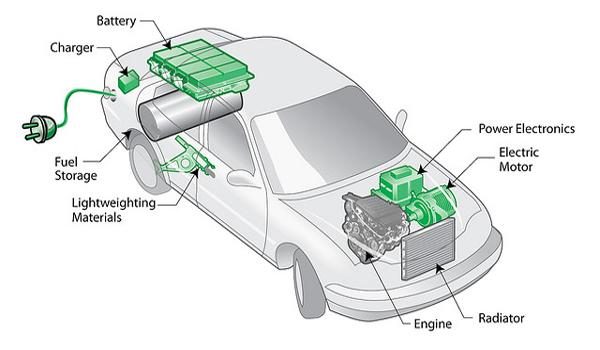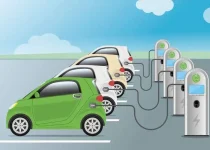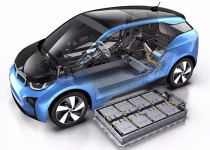How do electric vehicle powertrains differ from ICE powertrains?

Electric vehicle (EV) powertrains and internal combustion engine (ICE) powertrains differ significantly in terms of their components, energy sources, and overall operation. Here’s a comparison of the key differences between the two powertrains:
- Energy source: EV powertrains utilize electricity stored in a battery pack as their energy source, while ICE powertrains rely on the combustion of fossil fuels, such as gasoline or diesel, to generate mechanical power.
- Engine and motor: ICE powertrains have an internal combustion engine that converts the chemical energy stored in fuel into mechanical energy through a series of small explosions. In contrast, EV powertrains use an electric motor that converts electrical energy from the battery pack into mechanical energy to drive the wheels.
- Transmission: ICE vehicles typically require multi-speed transmissions to effectively transfer the engine’s power to the wheels across a wide range of speeds. EVs, on the other hand, generally have single-speed transmissions because electric motors have a broader torque curve and can deliver power efficiently across a wide range of speeds without the need for multiple gears.
- Efficiency: EV powertrains are generally more energy-efficient than ICE powertrains, as electric motors can convert a higher percentage of electrical energy into mechanical energy compared to the energy conversion in internal combustion engines.
- Emissions: EV powertrains produce zero tailpipe emissions, as there is no combustion process involved. ICE powertrains, on the other hand, emit greenhouse gases and pollutants through the combustion of fossil fuels.
- Noise and vibration: EV powertrains generate less noise and vibration compared to ICE powertrains, as they do not have the loud combustion process or numerous moving parts that create noise and vibration in ICE vehicles.
- Maintenance: EV powertrains typically require less maintenance than ICE powertrains because they have fewer moving parts and no need for oil changes, exhaust system repairs, or engine tune-ups. However, battery maintenance and eventual replacement are unique considerations for EVs.
- Regenerative braking: Many EVs incorporate regenerative braking, which allows the electric motor to act as a generator during braking, capturing some of the kinetic energy that would otherwise be lost as heat and converting it back into electrical energy to recharge the battery. This feature is not present in ICE powertrains.
- Instant torque: Electric motors in EV powertrains can deliver instant torque from a standstill, providing quick acceleration and a responsive driving experience. In contrast, ICE powertrains need to build up engine speed to achieve maximum torque, resulting in a more gradual acceleration curve.
Overall, electric vehicle powertrains offer several advantages over ICE powertrains, including higher efficiency, lower emissions, reduced noise and vibration, and simpler maintenance requirements. As EV technology continues to advance and become more affordable, the adoption of electric vehicles is expected to grow, leading to a cleaner and more sustainable transportation system.
To recap and expand upon the comparison between electric vehicle (EV) powertrains and internal combustion engine (ICE) powertrains, here are some additional points to consider:
- Cooling systems: Both EV and ICE powertrains require cooling systems to regulate temperature and prevent overheating. However, the cooling systems in EVs are typically simpler and more efficient, as they need to manage the temperature of the battery pack and electric motor, which generate less heat compared to an ICE. ICE powertrains require more complex cooling systems to manage the high temperatures produced during combustion.
- Energy recovery: While ICE powertrains are capable of recovering some waste heat through the use of turbochargers or exhaust gas heat recovery systems, these methods are less efficient than the regenerative braking systems used in EVs, which can capture a significant portion of the kinetic energy lost during deceleration.
- Fueling infrastructure: EV powertrains rely on charging infrastructure to refuel, which can be installed at home, at work, or in public locations. This offers the convenience of “refueling” an EV while parked, but charging times are generally longer than the time it takes to refuel an ICE vehicle. ICE powertrains, on the other hand, depend on a network of gasoline or diesel fueling stations, which can provide quick refueling but may not always be as conveniently located as an EV charging station.
- Flexibility in design: The compact and modular nature of EV powertrains allows for more flexibility in vehicle design compared to traditional ICE powertrains. This enables car manufacturers to create innovative vehicle designs with better packaging, more cabin space, and improved weight distribution.
These additional points further highlight the differences between electric vehicle powertrains and internal combustion engine powertrains, emphasizing the advantages of EVs in terms of efficiency, emissions, design flexibility, and energy recovery. As the EV charging infrastructure continues to expand and battery technology improves, electric vehicles are likely to become an increasingly popular choice for personal and commercial transportation needs.


